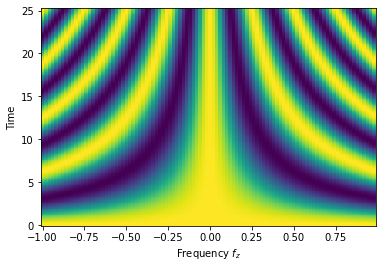[1]:
import quanguru as qg
import numpy as np
import matplotlib.pyplot as plt
import platform
10 - Single parameter sweep#
In the previous tutorial, we covered the simulation of a single qubit with the compute function. But, we run the simulation only for a single set of parameters, and, in most cases, we actually want to run the simulation for various different value of a parameter, say the qubit frequency. QuanGuru already provides this functionality, and it is the purpose of this tutorial to show how do we create/define a sweep. As you will see below, we don’t need to change any part of the existing single
parameter simulation, but we simply add a sweep.
Again, here, we will evolve the qubit under the unitary dynamics of its Hamiltonian \(H=\frac{1}{2}f_{z}\sigma_{z} = f_{z}J_{z}\) with the initial state set to the equal superposition of \(|1\rangle\) and \(|0\rangle\). We also set the total simulation time (with simTotalTime) and the step size (simStepSize) as well as the compute function where we compute the expectation value of \(\sigma_{x}\).
[2]:
# create the qubit and set its initial state and frequency
qub = qg.Qubit(frequency = 1)
qub.initialState = [0, 1]
# set the simulation time and step size
qub.simTotalTime = 8*np.pi
qub.simStepSize = 0.1
# create the operators for which we compute the expectation values
sigmaX = qg.sigmax()
# write a compute function that takes two arguments: (i) a quantum-system (qsys) and (ii) a state
# compute whatever we want and store in .resultsDict
def compute(qsys, state):
qsys.resultsDict['sigmax expectation'].append(qg.expectation(sigmaX, state))
# set the compute attribute of our qubit to compute function
qub.compute = compute
Now, the only thing needed is to add a Sweep. We do this by calling the .simulation.Sweep.createSweep on our qubit object and passing the relevant arguments. This rather lengthy and strange notation (.simulation.Sweep.createSweep) will become clearer in later tutorials, but, for now, we can intuitively read it as “create a new sweep (createSweep) among existing sweeps (Sweep) for the simulation (simulation) of our qubit (qub). This means that we can also carry
multi-parameter sweep, which will be covered in later tutorials.
Every new sweep requires a system (the qubit qub), a string for the attribute to be swept (qubit frequency "frequency"), and a list values to be swept (sweepList or other alternatives covered in later tutorials). Since, we can modify the frequency, operator, and/or order of the first term through the QuantumSystem objects, we simply use the qub as the system for the below sweep. However, we need to use the term object itself as the system when we want to sweep any parameter
of the other terms in the Hamiltonian (covered in later tutorials).
[3]:
freqSweep = qub.simulation.Sweep.createSweep(system=qub, sweepKey="frequency", sweepList=np.arange(-1, 1, 0.02))
At this point, all the essential information are set, and we can run the simulation by qub.runSimulation(). Since, the compute function will compute all the quantities we are interested, we again set simDelState to True.
Also, for parameter sweeps, QuanGuru can carry out parallel-processing, which means that each simulation for a set of parameters will run on the different cores of your cpu. For this, we simply set p=True when we call the runSimulation.
IMPORTANT NOTE FOR WINDOWS USERS : MULTI-PROCESSING (p=True) DOES NOT WORK WITH NOTEBOOK
You can use a python script, but you will need to make sure that the critical parts of the code are under if __name__ == "__main__": We are going to add further tutorials for this later.
[4]:
qub.simDelStates = True
states = qub.runSimulation(p=(platform.system() != 'Windows'))
Now, we receive the results that we stored again as qub.resultsDict['sigmax expectation'], but this time it returns a list of list, each of which is a time trace corresponding to the frequencies swept.
As expected, the expectation value of \(\sigma_{x}\) oscillates with different frequencies.
[5]:
Y, X = np.meshgrid(qub.simulation.timeList, freqSweep.sweepList)
plt.pcolormesh(X, Y, qub.resultsDict['sigmax expectation'])
plt.xlabel("Frequency $f_{z}$")
plt.ylabel("Time")
[5]:
Text(0, 0.5, 'Time')

[ ]: